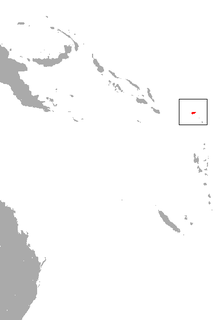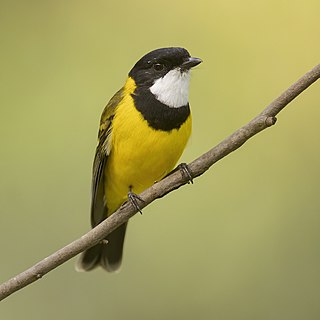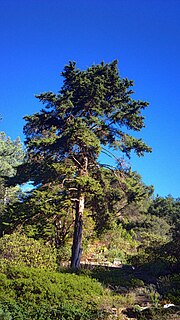
The monarchs comprise a family of over 100 passerine birds which includes shrikebills, paradise flycatchers, and magpie-larks.

The island scrub jay also island jay or Santa Cruz jay is a bird in the genus, Aphelocoma, which is endemic to Santa Cruz Island off the coast of Southern California. Of the over 500 breeding bird species in the continental U.S. and Canada, it is the only insular endemic landbird species. The island scrub jay (ISSJ) is closely related to the California scrub jay – the coastal population found on the adjacent mainland – but differs in being larger, more brightly colored, and having a markedly stouter bill. They will bury, or cache, the acorns in the fall and may eat them months later. They also eat insects, spiders, snakes, lizards, mice and other birds' eggs and nestlings.

The Nendo or Santa Cruz tube-nosed fruit bat is a megabat from the Santa Cruz Group of the Solomon Islands, near the eastern limit of the distribution of tube-nosed fruit bats. It has tube-like nostrils and a wingspan of about 40 cm.

The Australian golden whistler or golden whistler, is a species of bird found in forest, woodland, mallee, mangrove and scrub in Australia Most populations are resident, but some in south-eastern Australia migrate north during the winter. Its taxonomy is highly complex and remains a matter of dispute, with some authorities including as many as 59 subspecies of the golden whistler, while others treat several of these as separate species.

The Santa Cruz cypress is a species of North American tree within the Cypress family. The species is endemic to the Santa Cruz Mountains within the Santa Cruz and San Mateo counties of west-central California. The U.S. Fish and Wildlife Service listed the species on the Endangered Species Act in 1987 due to increasing threats from habitat loss and disruption of natural forest fire regimes. In 2016, the conservation status of the Santa Cruz cypress changed to Threatened. The cited reasoning was a decrease in threats against their habitat.
Ischnocnema sanctaecrucis is a frog species in the family Craugastoridae. It is endemic to Bolivia where it is known from the Santa Cruz and Cochabamba Departments. It is an uncommon, terrestrial frog inhabiting the Yungas forest ; it tolerates disturbed habitats. It has been found under rocks; males have been observed perching on small secondary vegetation. It is not considered threatened by the IUCN. Its range includes the Carrasco and Amboró National Parks.
The Santa Cruz ground dove is a species of bird in the family Columbidae. It is found in the southern Solomon Islands and Vanuatu. Its natural habitat is subtropical or tropical moist lowland forests. It is threatened by habitat loss.
The Rennell shrikebill is a songbird species in the family Monarchidae endemic to the Solomon Islands. Its natural habitat is subtropical or tropical moist lowland forests.

The shrikebills are the monarch flycatcher genus Clytorhynchus. The five species have long laterally compressed bills similar to true shrikes that give them their names. The genus is endemic to the islands of Melanesia and western Polynesia.

The black-throated shrikebill or black-faced shrikebill is a songbird species in the family Monarchidae.

The southern shrikebill, or brown flycatcher, is a songbird species in the family Monarchidae. It is found in New Caledonia and Vanuatu. Its natural habitat is subtropical or tropical moist lowland forests.

The Fiji shrikebill is a songbird species in the family Monarchidae. It is found in American Samoa, Fiji, and Tonga. Its natural habitat is subtropical or tropical moist lowland forests.

A shrikethrush, also spelt shrike-thrush, is any one of five species of songbird that is a member of the genus Colluricincla. They have nondescript, predominantly brown or grey, plumage, but are accomplished singers, their calls described as "strong, mellow and beautiful." Shrikethrushes are generally insectivorous, though have been recorded eating molluscs and berries. They build cup-shaped nests in the forks of trees.
The Vanikoro monarch is a species of bird in the monarch family endemic to the Santa Cruz Islands. Its natural habitat is subtropical or tropical moist lowland forests and it is threatened by habitat loss. Alternate names for the Vanikoro monarch include slaty flycatcher, small slaty flycatcher, small slaty monarch and the Vanikoro flycatcher.
The Biak monarch, or Biak monarch flycatcher, is a species of bird in the family Monarchidae. It is endemic to Biak Island, Indonesia.
Sanford's white-eye is a species of bird in the family Zosteropidae. It is endemic to Nendo Island.
The Santa Cruz white-eye is a species of bird in the family Zosteropidae. It is endemic to the Solomon Islands.
The Saint Croix racer is a species of snake in the family Colubridae. The species is endemic to Saint Croix, United States Virgin Islands.

The Vanikoro flying fox, also known locally as basapine, is a species of bat in the family Pteropodidae. It has only been found in the Vanikoro island group located in the southern Solomon Islands. The species as a whole was originally known from just a few specimens collected sometime before 1930 but following surveys conducted on the island in the early 1990s did not detect this species again causing the Vanikoro flying fox to be listed as extinct. However, the species was rediscovered by a survey conducted in late 2014 which indicated a population in the high hundreds or low thousands and reported all observations.
The Vanikoro white-eye is a species of bird in the family Zosteropidae. It is endemic to Vanikoro in the Santa Cruz Islands of Temotu Province in the south-east of the Solomon Islands chain. The species is named for David Gibbs, who discovered it.










